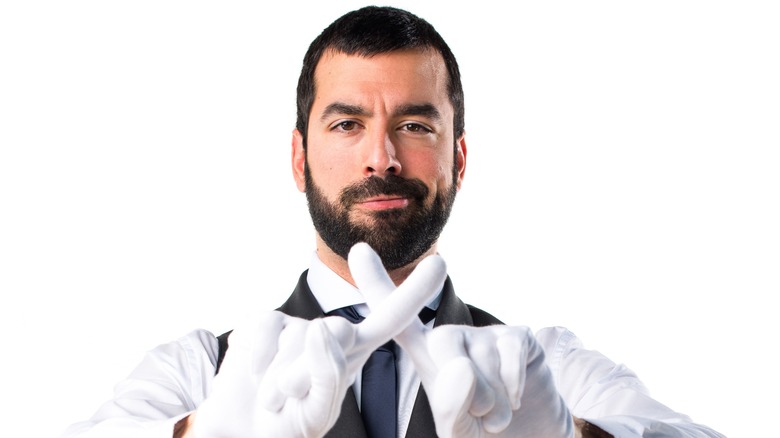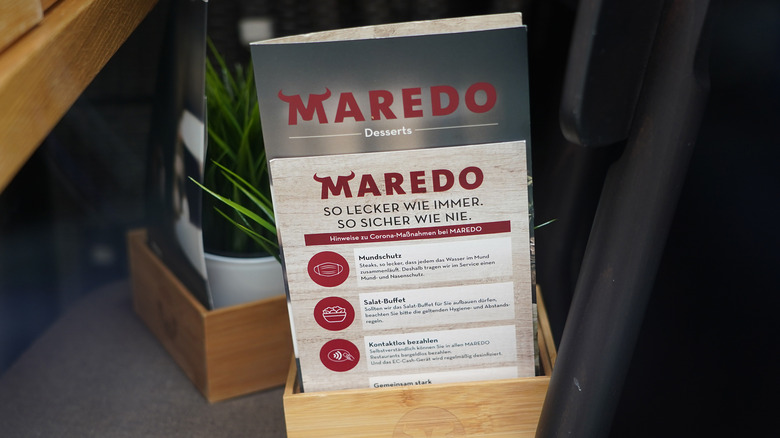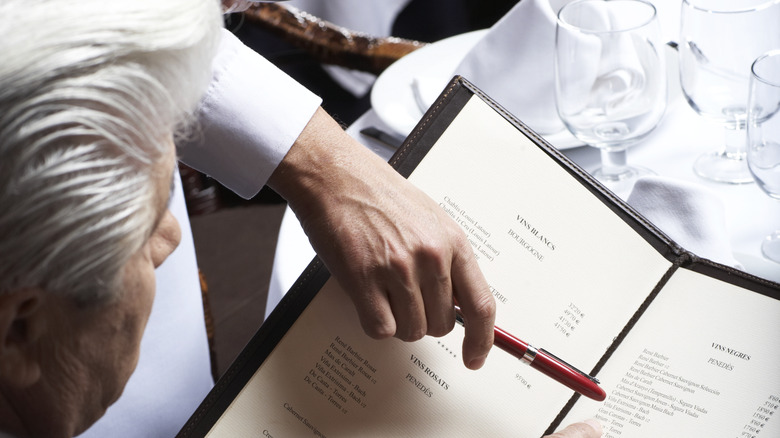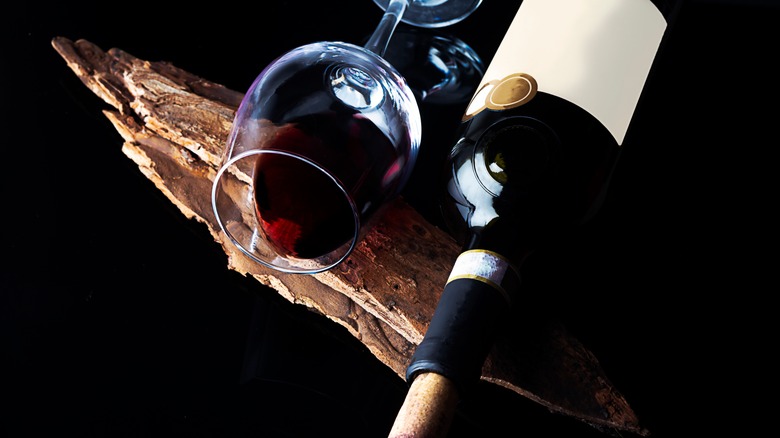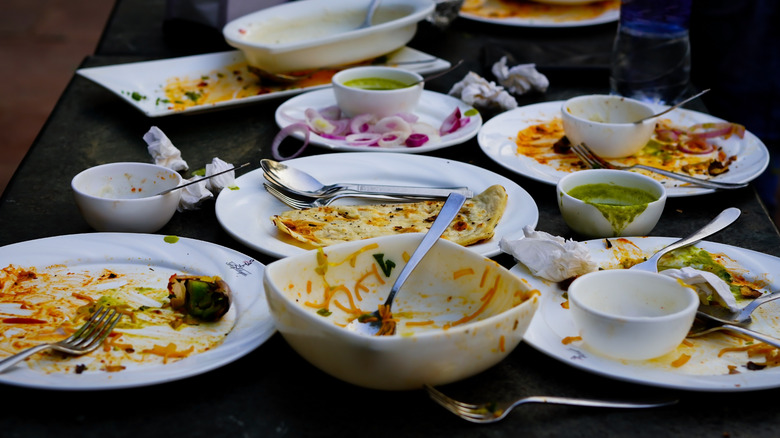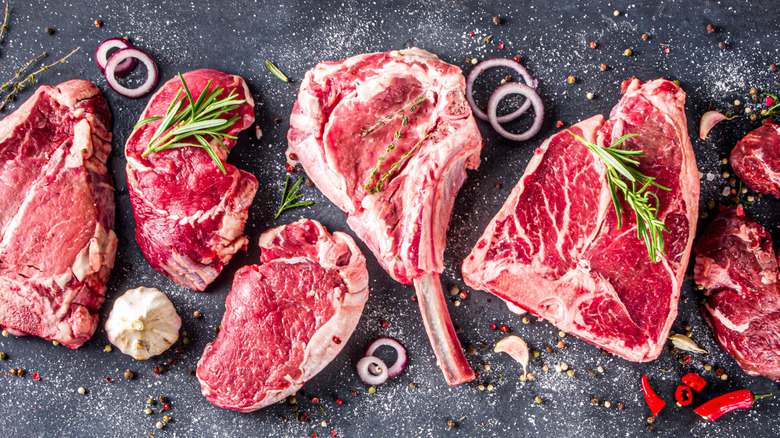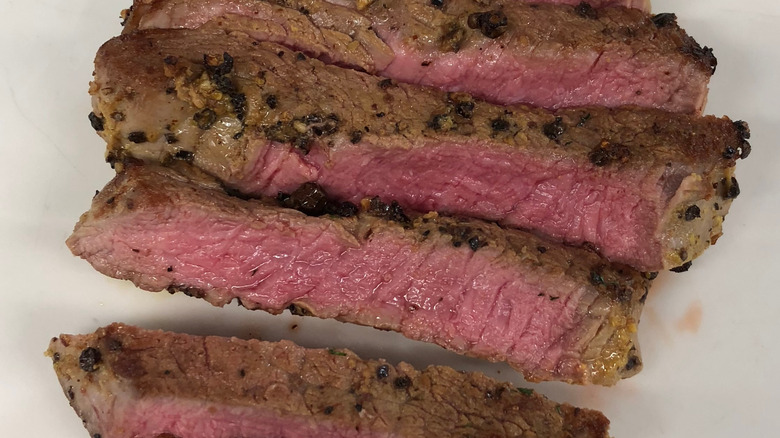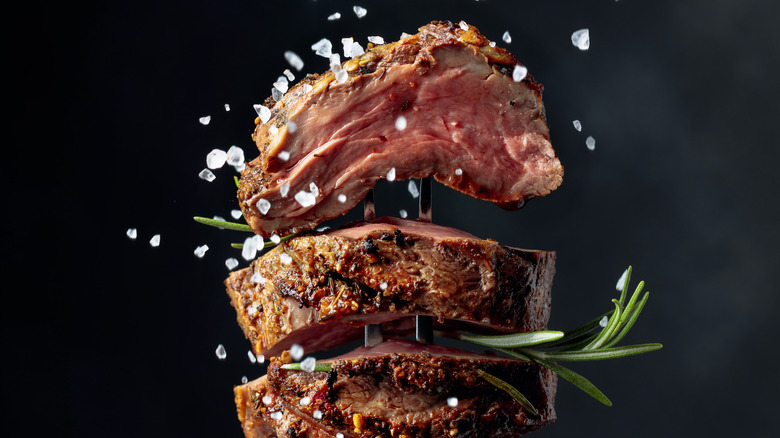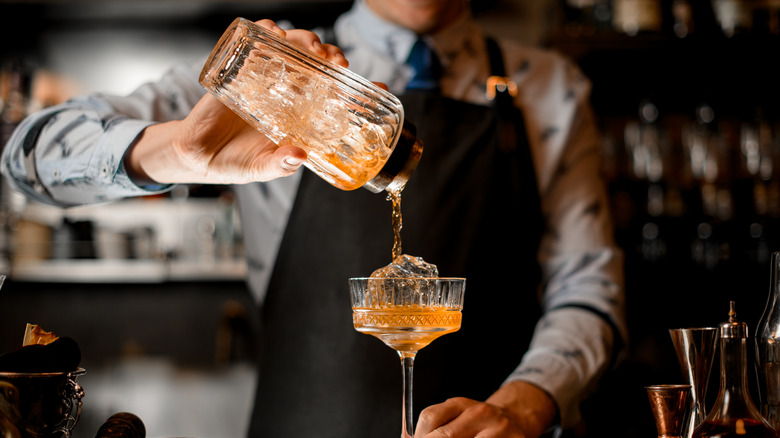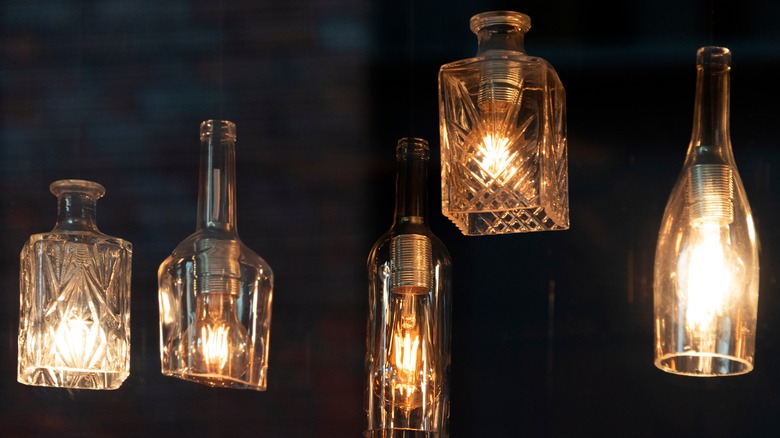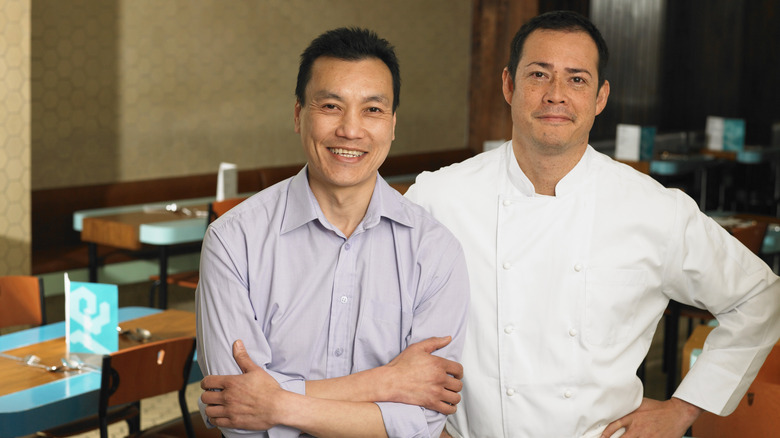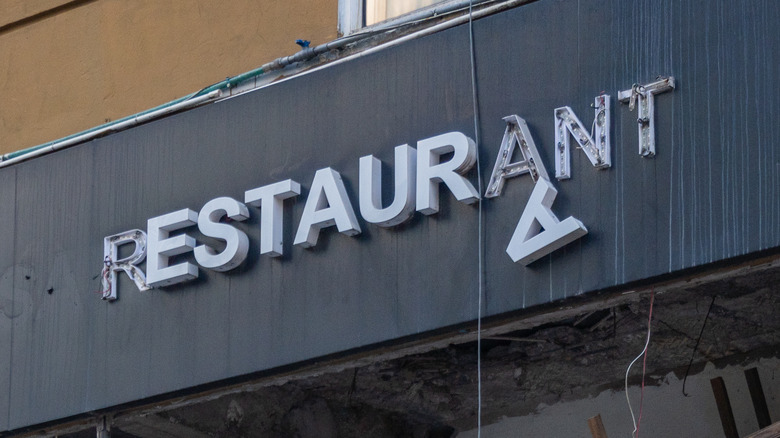14 Red Flags You Should Look Out For At Steakhouses
The steakhouse has been an American dining staple since the mid-1800s. They were inspired by London chop houses and first originated in the New York City Meatpacking District. Modern steakhouses range from local establishments to large chains like Outback Steakhouse, Texas Roadhouse, and LongHorn Steakhouse, all of which have more than 550 U.S. locations as of 2021 (via Statista).
Some of the original New York steakhouses are still around: The Old Homestead Steakhouse has operated continuously since 1868, and Keens Steakhouse was established in 1885 . Despite the crowded modern restaurant market, the classic steakhouse still has its place. FSR notes the best steakhouses provide fine dining and service that goes beyond an ordinary sit-down restaurant. In effect, you're paying for more than just a meal: You're paying for an experience.
It goes without saying the experience should be a good one. But like any type of restaurant, there are good and bad steakhouses, and you don't want a meal spoiled by choosing an establishment with terrible food, unprofessional service, or something else that ruins an outing. Watch for these signs you're in a bad steakhouse to avoid disaster and ensure you enjoy a great meal and dining experience.
1. The service is slow and/or rude
Steakhouses are a popular choice to celebrate business milestones, birthdays, and other important occasions. But even if it isn't a special event per se, the staff's goal should be to make your night feel special. After all, steakhouses are expensive, in part because you're paying for high-quality meat. With restaurants such as CraftSteak sometimes charging more than $100 for a single meal, it's reasonable to expect good service to go with it.
In fact, service may be the most important thing about a steakhouse visit. A 2013 study by the University of Denver Daniels College of Business found service and ambiance had a bigger impact on people's willingness to pay more than food quality did. And the 2010 Customer Experience Impact Report by RightNow noted 82 percent of people will stop frequenting a specific place of business if they have a bad experience.
Therefore, bad service is a huge steakhouse red flag. Waiting forever for someone to take your order and/or a collective bad attitude from the staff are signs you might want to go elsewhere. If your food is taking forever with no updates or apologies, some experts say it's okay to just pay for your drinks and leave.
2. The menu doesn't have much information about the food
Another warning sign is a steakhouse menu that just lists the names of dishes and nothing else. Many modern diners want to know exactly what's in their meal. A study in Food Quality and Preference discovered that, for people who are considered "highly involved" with food, the ingredient combination is the most important factor for choosing a meal at fine dining restaurants. Things such as nutritional information, sustainable sourcing, and trying to avoid certain foods also play a role.
The FDA requires restaurant chains with at least 20 locations to list calorie counts. Additionally, anything that potentially contains a major food allergen must be labeled. But a good steakhouse should also tell you where they source their meat and describe it beyond just the cut of beef.
Sparse info may be a sign of lower-quality food or management disinterest. It doesn't have to be a novel: The Y.O. Ranch Steakhouse menu that lists the items in each dish and gives the USDA beef rating goes a long way. You still might watch out, though, as there have been cases of restaurants lying about where their food comes from.
3. The server doesn't know anything about the food
Servers should know the menu and be able to answer any questions you have. Many experts have noted how important menu knowledge is for good restaurant service. Notably, according to the OC Register, knowing the menu is the number one qualification for being a better waiter.
At a minimum, your steakhouse server should have the menu memorized so they describe each item and identify any dishes that are vegetarian, gluten-free, etc., to meet dietary requirements. They also should know what the different foods look and taste like as well as how they're made. Ideally, the servers should have personally tried the dishes on the menu so they can confidently answer any questions that customers may have.
If your questions about the menu are greeted by half-hearted answers, blank stares, rambling answers, or simply "I don't know," alarm bells should be going off. That being said, it's not necessarily the waitstaff's fault. An uninformed server is often an indicator of ownership or management not giving them proper training. Regardless of the cause, not being able to get the info you need from your server is a sign you're at a bad steakhouse.
4. The wine list is bad
Wine and steak have long been a perfect coupling. It's a scientific match: A study in Current Biology found the contrasting sensory feelings balance each other out for a better mouthfeel. Still, you need the right wine for the meal, and a bad steakhouse wine list can put a damper on your evening.
Although there is no "no size fits all" when it comes to wine lists, there are a few things you should look out for, especially since many restaurants reduced their lists due to the COVID-19 pandemic. While some trumpet the benefits of an extensive wine list, a shorter list is fine as long as it's not just variations on the same thing. Wine lists should also be easy to follow. If the list is poorly organized and has no information about the wines, be on alert.
Other bad signs are if the wines don't pair well with the steaks or don't match the restaurant's character. Spelling mistakes and a lack of pricing options are also causes for concern. Finally, look for a sommelier or someone else on staff who's knowledgeable about wine. As restaurant owner Cathy Whims tells SevenFiftyDaily, this should be considered part of giving customers a memorable experience.
5. The place is dirty
Messes are inevitable when cooking and eating, but you should be worried when a steakhouse isn't cleaning up after those messes. Cleanliness is a huge deal when it comes to any eatery, never mind a fancy steakhouse. According to a Consumer Reports survey, dirty utensils/tables (76 percent) and dirty bathrooms (73 percent) are the two things restaurant guests complain about the most. A Virginia Tech study also found restroom cleanliness is what most impacts someone's perception of a restaurant. If a steakhouse can't be bothered with these customer-facing areas, just think how bad the kitchen might be.
Beyond just being careless, dirty steakhouses are dangerous. The CDC estimates that each year, 48 million Americans get a foodborne illness, and 128,000 require hospitalization as a result. Failing to maintain a steakhouse can lead to dangerous germs such as salmonella and norovirus getting in your food. The appearance and behavior of servers are important, too, as poor hygiene or failure to follow CDC food safety guidelines can cause contamination. If you see obvious signs of a steakhouse that isn't keeping things clean, we recommend getting out of there and maybe taking a shower when you get home.
6. You receive the wrong cut of steak
There are a lot of beef cuts out there: Certified Angus Beef lists 63, from top-blade steak to bone-in ribeye. However, that's no excuse for not getting the steak you paid for. Each cut has its distinct flavor, texture, and best cooking method, which a steakhouse customer has every right to expect.
Sadly, unscrupulous steakhouses will prey on people who don't know the difference between top sirloin and porterhouse, serving one steak and charging them for a more expensive cut. For example, a 2016 investigation by Inside Edition found many U.S. restaurants not certified to serve Japanese Kobe beef were instead serving lower-quality meat and calling it Kobe. These weren't just no-name local steakhouses, either: Old Homestead Steakhouse, the oldest steakhouse in the U.S., was one of the culprits. So was Le Bernardin, a New York restaurant with three Michelin stars.
This steak fake-out happens at chains, too, with one TripAdvisor reviewer blasting a former Outback Steakhouse location in Tacoma, Washington, for serving them a rump roast after they ordered filet mignon. If you're unfamiliar with the various steak cuts, do a little research beforehand to protect yourself from unwittingly dining on an incorrect steak.
7. Your steak isn't cooked the way you ordered it
People have debated how thoroughly to cook a steak for a long time, and each has its supporters: Yes, even well-done. What isn't up for debate, though, is that a steakhouse customer should receive their meal the way they requested it.
Each level of steak doneness (rare, medium-rare, etc.) has very specific internal temperature, color, and texture requirements. Also, Insider points out different cuts taste best at different doneness levels, so an undercooked or overcooked steak will have a big impact on the eating experience.
Sometimes, though, you'll get a steak that wasn't cooked properly, and it may not be an accident. In 2018, a New York Post investigation brought to light that many restaurants were deliberately undercooking steaks. Apparently, it's because eateries know an undercooked steak can be fixed in a couple of minutes while an overcooked steak has to be thrown out.
According to a 2007 USDA report, up to 5 percent of restaurant-served beef is discarded because customers thought it was overcooked. But we think occasionally having to toss a steak because of one unhappy customer is better than undercooking everything and having a lot of unhappy customers.
8. The meat has too much salt
While a little salt can add to a steak's taste, a little more could be a sign you're at a bad steakhouse. Though you've almost surely heard at least once that "good steak doesn't need to be seasoned," meat and grilling experts such as Traeger agree the right amount of salt and seasoning will enhance the taste. The general rule is one teaspoon of salt per pound of beef evenly spread across both sides.
Putting more salt than this on a steak will hinder the natural flavor and might even make it inedible. Oversalting steak is also a health issue, as too much salt raises a person's risk of high blood pressure, stroke, and heart disease. More cynically, salt is a preservative, and many restaurants use it to help food last longer (via Time). So if your steak is overly salty, it could mean the meat is older or of lower quality.
There's also the question of when to salt the meat. Some experts claim that salting a steak before you cook it will dry it out. Therefore, a really tough steak could be a seasoning problem rather than an overcooking problem.
9. Uninspired side dishes
The steak is certainly the star at a steakhouse. But even great lead actors need a few good supporting actors to truly shine. Side dishes add variety to your meal and provide balance in terms of both flavors and essential nutrients. If a steakhouse clearly hasn't put much effort into its side dishes, that's almost as bad as messing up the steaks.
The Herald-Standard has written about the side dish problem as it relates to cookouts: People put a lot of time and care into their entrée but just "throw something together" to go with it. Side dishes matter, though, and you shouldn't settle for the same problem at a fine dining establishment. Check the side dish menu when you arrive, as it can give you a lot of insight.
So what should you look for? Some side dishes like baked potatoes, salad, and roasted vegetables, are considered timeless standards for steak. While these are fine, watch for steakhouses that give the side dish a creative spin. Chicago Magazine lists options like lobster mac n' cheese, barbecue-rubbed sweet potatoes, and roasted tomatoes at steakhouses across the country that will liven up the main course.
10. The bartender can't make the cocktail you want
A nice drink or two is part of relaxing and unwinding at a special meal. For those who aren't a fan of wine, many steakhouses have a bar where you can order cocktails, that is, as long as the bartender is able to make them.
The Maryland Bartending Academy lists being able to make a lot of different drinks as one of the characteristics of a good bartender. If they don't know how to make a commonly-known cocktail or other mixed drink, and worse, aren't willing to find out, it's a telltale sign of staff that is inexperienced, untrained, or simply doesn't care.
A lack of cocktail knowledge is especially heinous when you consider that the typical profit margin on cocktails is 10 to 15 percent higher than the profit margin on food (via Binwise). Steakhouses that are neglecting this easy money likely have other problems, too.
A decent steakhouse bartender should at least be able to mix most of the drinks on the International Bartender Association Official Cocktail List without stopping to look them up. They should also be patient, confident, organized, and communicative. A good bartender can make a huge difference to the quality of your visit.
11. The décor is old and antiquated
While the interior décor of a steakhouse may not necessarily make the food better or worse, it is surprisingly important. A 2014 study from the Rochester Institute of Technology examined the importance of restaurant interior design, determining it has a big impact on both customer perception and the restaurant's public image. In some cases, customers were even willing to pay more at eateries with certain design features.
Yet a 2019 survey by Zoro found that nearly 60 percent of frequent diners have experienced eating in a restaurant with outdated décor (via FSR). Many people "eat with their eyes" before eating off their plates, and if the décor hasn't been refreshed in a while, it leaves a poor taste. It also shows management and ownership aren't putting the effort into creating a good atmosphere, which can detract from any restaurant experience.
Just ask this TGI Fridays reviewer on TripAdvisor who compared the atmosphere to a funeral home. Steakhouses are already fighting a shift in dining preferences and the perception among younger audiences that they're uncool, and bad décor certainly isn't going to help that perception.
12. They won't make things right if there's a mistake
We fully recognize that nobody's perfect, and even the best steakhouses make mistakes. Occasionally, you'll experience mixed-up reservations, servers saying something they shouldn't, chefs preparing food incorrectly, and other snafus.
But to paraphrase an old saying, you learn a lot more about a steakhouse when things go wrong than when things go right. The Washington Post writes that good restaurant owners and managers want customers to speak up if there's an issue so they can fix it. Many also offer gift cards, discounts, and other incentives to encourage you to come back.
Conversely, if a steakhouse dismisses your complaint or doesn't even respond, it's a sign they don't respect their customers. The sad reality is they sometimes don't even need to do much. One survey by GatherUp found almost 43 percent of people were willing to give a business at least three days to respond to their complaint!
At the same time, remember there's a right and wrong way to complain. If you come off like a jerk, such as the man who called 911 to gripe about his order being too small, then even good steakhouses are less likely to assist you (via NPR).
13. You're one of the only people there
Since there are so many steakhouses and eating options out there, you can't expect all of them to be full all the time. And seeing a steakhouse nearly empty one time isn't necessarily reason for pause. Some get most of their customers on the weekends, while others survive on happy hour patrons. There may be other extenuating factors as well, such as a robust takeout business.
All that said, if a steakhouse is practically empty pretty much every time you drive past or peek in the window, it's a potential red flag. Fast Company writes seeing an eatery that's crowded versus one that's unoccupied is "Social Proof."
In other words, people subconsciously interpret the full steakhouse as having good food and service while viewing the vacant one as not being good. If nothing else, this at least gives a steakhouse the reputation of being a poor place to eat
Again, an almost empty steakhouse isn't definitive proof that it's bad. It could be that people are staying away in droves due to known problems, or it's possible that the owners didn't have much of a marketing budget. Nevertheless, it's a factor you should consider before deciding whether to pay a specific establishment a visit.
14. Poor signage and websites
In some cases, you don't even have to walk through the door to know a steakhouse is bad. Good steakhouse owners realize well-done signs and websites are a big part of getting people to show up. A poll conducted by Custom Neon found almost 79 percent of people consider signage to be an indicator of how good the business is, and 72 percent believe it's more important than social media.
As for online presence, the MGH marketing agency found that 68 percent of people have been dissuaded from going to a restaurant due to its website. Some of the reasons given for this beyond food choices include the website being hard to navigate, hard to read, or looking out of date. Having both these things in order is a must for a successful steakhouse. The signs and website are the first indication to customers of the restaurant's standards.
If a steakhouse clearly doesn't care about how it presents itself to potential customers, that's bad news for the food itself. Of course, not everyone wants the same thing: Some like bright eye-catching designs, while others prefer signs filled with information. But simply having a professional look is a good sign.

